Python 数据科学之 Pandas
生成 Series 数据
用值列表生成 Series 时,Pandas 默认自动生成整数索引:
import numpy as np
import pandas as pd
s = pd.Series([1, 3, 5, np.nan, 6, 8])
s
# Output
0 1.0
1 3.0
2 5.0
3 NaN
4 6.0
5 8.0
dtype: float64用含日期时间索引与标签的 NumPy 数组生成 DataFrame:
dates = pd.date_range('20130101', periods=6)
dates
# Output
DatetimeIndex(['2013-01-01', '2013-01-02', '2013-01-03', '2013-01-04', '2013-01-05', '2013-01-06'],
dtype='datetime64[ns]', freq='D')df = pd.DataFrame(np.random.randn(6, 4), index=dates, columns=list('ABCD'))
dfOutput:

用 Series 字典对象生成 DataFrame:
df2 = pd.DataFrame({'A': 1.,
'B': pd.Timestamp('20130102'),
'C': pd.Series(1, index=list(range(4)), dtype='float32'),
'D': np.array([3] * 4, dtype='int32'),
'E': pd.Categorical(["test", "train", "test", "train"]),
'F': 'foo'})
df2Output:

DataFrame 的列有不同数据类型:
df2.dtypes
# Output
A float64
B datetime64[ns]
C float32
D int32
E category
F object
dtype: objectIPython支持 tab 键自动补全列名与公共属性。下面是部分可自动补全的属性:
df2.Adf2.absdf2.adddf2.add_prefixdf2.add_suffixdf2.aligndf2.alldf2.anydf2.appenddf2.applydf2.applymapdf2.Ddf2.booldf2.boxplotdf2.Cdf2.clipdf2.clip_lowerdf2.clip_upperdf2.columnsdf2.combinedf2.combine_firstdf2.compounddf2.consolidate
列 A、B、C、D 和 E 都可以自动补全;为简洁起见,此处只显示了部分属性。
查看数据
# 查看 DataFrame 头部数据
df.head()
# 查看 DataFrame 尾部数据
df.tail(3)
# 显示索引
df.index
# 显示列名
df.columns
# 显示值
df.values
# 快速查看数据的统计摘要
df.describe()
# 转制数据
df.T
# 按轴排序
df.sort_index(axis=1, ascending=False)
# 按值排序
df.sort_values(by='B')获取数据
选择
提醒
选择、设置标准 Python / Numpy 的表达式已经非常直观,交互也很方便,但对于生产代码,我们还是推荐优化过的 Pandas 数据访问方法:.at、.iat、.loc和.iloc。
# 选择单列,产生 Series,与 `df.A` 等效
df['A']
# Output
2013-01-01 -1.208257
2013-01-02 -1.102261
2013-01-03 -0.059864
2013-01-04 0.644392
2013-01-05 -1.350474
2013-01-06 1.402061
Freq: D, Name: A, dtype: float64按标签选择
# 用标签提取一行数据
df.loc[dates[0]]
# Output
A -1.208257
B 2.018486
C 0.679159
D -0.587707
Name: 2013-01-01 00:00:00, dtype: float64
# 用标签选择多列数据
df.loc[:, ['A', 'B']]Output:

用标签切片,包含行与列结束点
df.loc['20130102':'20130104', ['A', 'B']]Output:

# 返回对象降维
df.loc['20130102', ['A', 'B']]
# Output
A -1.102261
B -0.538013
Name: 2013-01-02 00:00:00, dtype: float64
# 提取标量值
df.loc[dates[0], 'A']
# Output
-1.2082567185245703
# 快速访问标量,与 loc 等效
df.at[dates[0], 'A']
# Output
-1.2082567185245703按位置选择
用整数位置选择:
df.iloc[3]
# Output
A 0.644392
B 0.316984
C -0.583878
D 1.197701
Name: 2013-01-04 00:00:00, dtype: float64
# 类似 NumPy / Python,用整数切片:
df.iloc[3:5, 0:2]Output:

# 类似 NumPy / Python,用整数列表按位置切片:
df.iloc[[1, 2, 4], [0, 2]]Output:
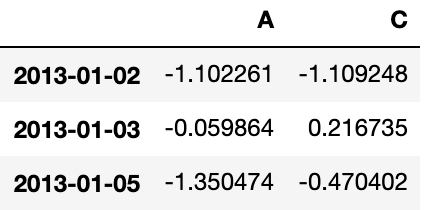
# 显式整行切片
df.iloc[1:3, :]Output:

# 显式整列切片
df.iloc[:, 1:3]Output:

# 显式提取值
df.iloc[1, 1]
# Output
-0.5380131662468983
# 快速访问标量 等效与 iloc
df.iat[1, 1]
# Output
-0.5380131662468983布尔索引
# 用单列的值选择数据
df[df.A > 0]Output:

# 选择 DataFrame 里满足条件的值
df[df > 0]Output:
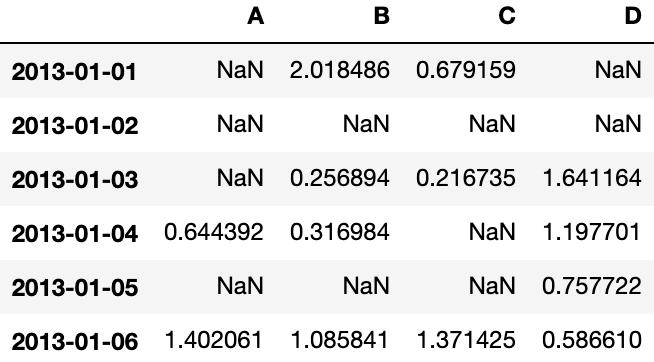
# 用 isin() 筛选
df2 = df.copy()
df2['E'] = ['one', 'one', 'two', 'three', 'four', 'three']
df2Output:

df2[df2['E'].isin(['two', 'four'])]Output:

赋值
用索引自动对齐新增列的数据:
s1 = pd.Series([1, 2, 3, 4, 5, 6], index=pd.date_range('20130102', periods=6))
s1
# Output
2013-01-02 1
2013-01-03 2
2013-01-04 3
2013-01-05 4
2013-01-06 5
2013-01-07 6
Freq: D, dtype: int64df['F'] = s1
# 按标签赋值
df.at[dates[0], 'A'] = 0
# 按位置赋值
df.iat[0, 1] = 0
# 按 NumPy 数组赋值
df.loc[:, 'D'] = np.array([5] * len(df))
dfOutput:

# 用 where 条件赋值
df2 = df.copy()
df2[df2 > 0] = -df2
df2Output:
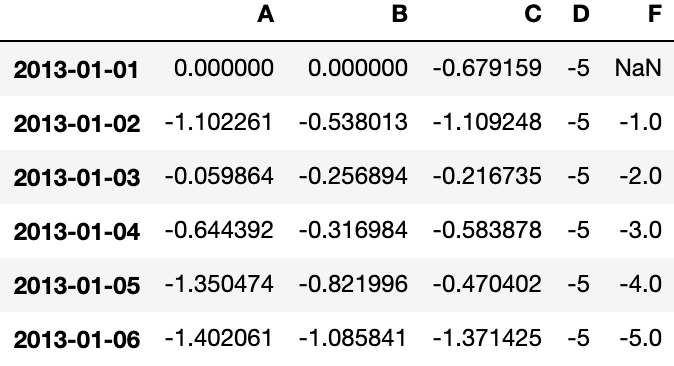
缺失值
Pandas 主要用 np.nan 表示缺失数据。 计算时,默认不包含空值。详见缺失数据。
重建索引(reindex)可以更改、添加、删除指定轴的索引,并返回数据副本,即不更改原数据。
df1 = df.reindex(index=dates[0:4], columns=list(df.columns) + ['E'])
df1.loc[dates[0]:dates[1], 'E'] = 1
df1Output:

# 删除所有含缺失值的行
df1.dropna(how='any')Output:

# 填充缺失值
df1.fillna(value=5)Output:
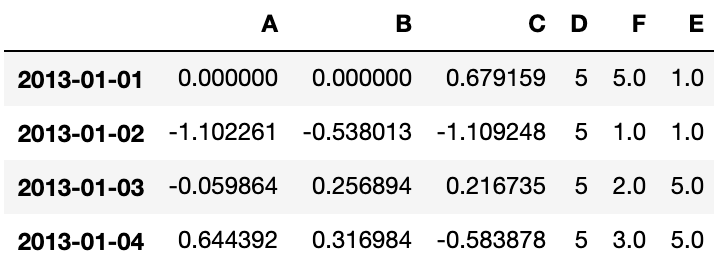
# 提取 nan 值的布尔掩码
pd.isna(df1)
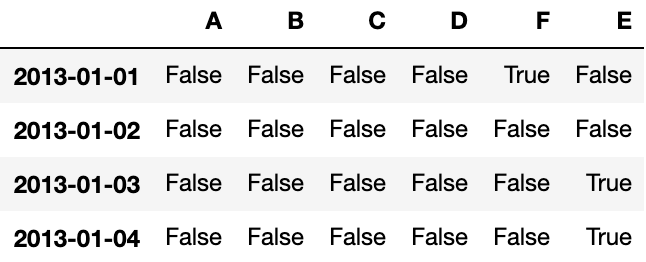
运算
统计
一般情况下,运算时排除缺失值。
描述性统计:
df.mean()
# Output
A -0.077691
B 0.049952
C 0.017299
D 5.000000
F 3.000000
dtype: float64
# 在另一个轴(即,行)上执行同样的操作
df.mean(1)
# Output
2013-01-01 1.419790
2013-01-02 0.650095
2013-01-03 1.482753
2013-01-04 1.675500
2013-01-05 1.271426
2013-01-06 2.771865
Freq: D, dtype: float64
# 不同维度对象运算时,要先对齐。 此外,Pandas 自动沿指定维度广播
s = pd.Series([1, 3, 5, np.nan, 6, 8], index=dates).shift(2)
s
# Output
2013-01-01 NaN
2013-01-02 NaN
2013-01-03 1.0
2013-01-04 3.0
2013-01-05 5.0
2013-01-06 NaN
Freq: D, dtype: float64df.sub(s, axis='index')
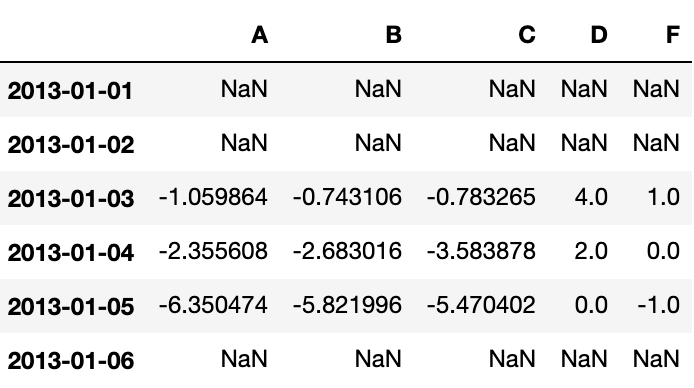
Apply 函数
Apply 函数处理数据:
df.apply(np.cumsum)Output:

df.apply(lambda x: x.max() - x.min())
# Output
A 2.752535
B 1.907837
C 2.480673
D 0.000000
F 4.000000
dtype: float64直方图
s = pd.Series(np.random.randint(0, 7, size=10))
s
# Output
0 2
1 5
2 1
3 6
4 0
5 0
6 6
7 0
8 6
9 3
dtype: int64
s.value_counts()
# Output
6 3
0 3
5 1
3 1
2 1
1 1
dtype: int64字符串方法
Series 的 str 属性包含一组字符串处理功能,如下列代码所示。注意,str 的模式匹配默认使用正则表达式。详见矢量字符串方法。
s = pd.Series(['A', 'B', 'C', 'Aaba', 'Baca', np.nan, 'CABA', 'dog', 'cat'])
s.str.lower()
# Output
0 a
1 b
2 c
3 aaba
4 baca
5 NaN
6 caba
7 dog
8 cat
dtype: object合并(Merge)
结合(Concat)
Pandas 提供了多种将 Series、DataFrame 对象组合在一起的功能,用索引与关联代数功能的多种设置逻辑可执行连接(join)与合并(merge)操作。concat() 用于连接 Pandas 对象:
df = pd.DataFrame(np.random.randn(10, 4))
dfOutput:

# 分解为多组
pieces = [df[:3], df[3:7], df[7:]]
pd.concat(pieces)Output:
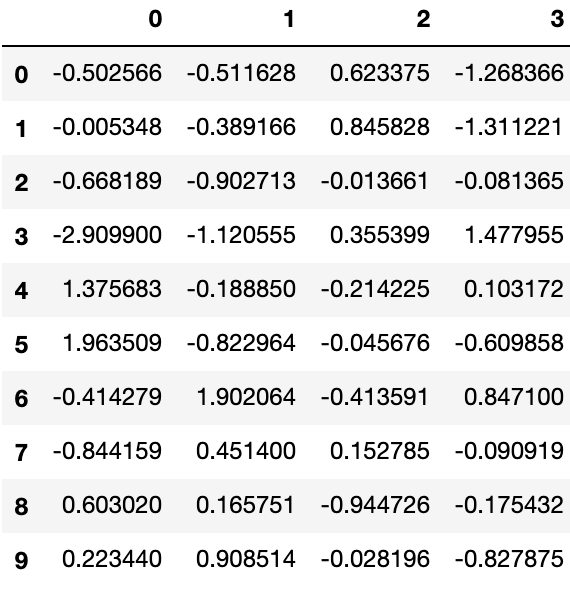
连接(join)
SQL 风格的合并。 详见数据库风格连接
left = pd.DataFrame({'key': ['foo', 'foo'], 'lval': [1, 2]})
right = pd.DataFrame({'key': ['foo', 'foo'], 'rval': [4, 5]})
leftOutput:

rightOutput:
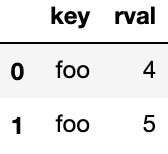
合并
pd.merge(left, right, on='key')Output:

left = pd.DataFrame({'key': ['foo', 'bar'], 'lval': [1, 2]})
right = pd.DataFrame({'key': ['foo', 'bar'], 'rval': [4, 5]})
leftOutput:

rightOutput:
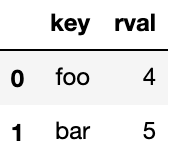
pd.merge(left, right, on='key')Output:
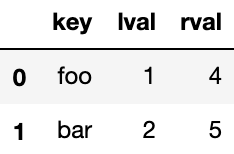
追加(Append)
为 DataFrame 追加行。
df = pd.DataFrame(np.random.randn(8, 4), columns=['A', 'B', 'C', 'D'])
dfOutput:
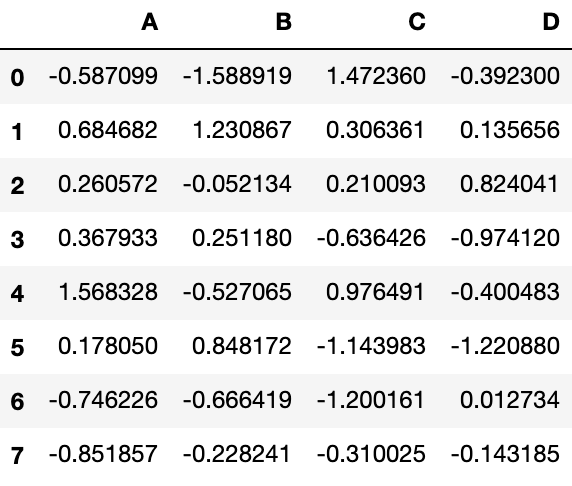
s = df.iloc[3]
df.append(s, ignore_index=True)Output:
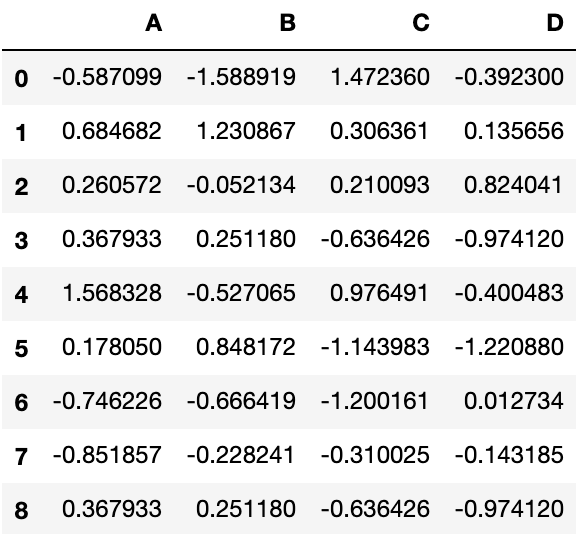
分组(Grouping)
“group by” 指的是涵盖下列一项或多项步骤的处理流程:
- 分割:按条件把数据分割成多组;
- 应用:为每组单独应用函数;
- 组合:将处理结果组合成一个数据结构。
df = pd.DataFrame({'A': ['foo', 'bar', 'foo', 'bar', 'foo', 'bar', 'foo', 'foo'], 'B': ['one', 'one', 'two', 'three', 'two', 'two', 'one', 'three'], 'C': np.random.randn(8), 'D': np.random.randn(8)}) df
Output:
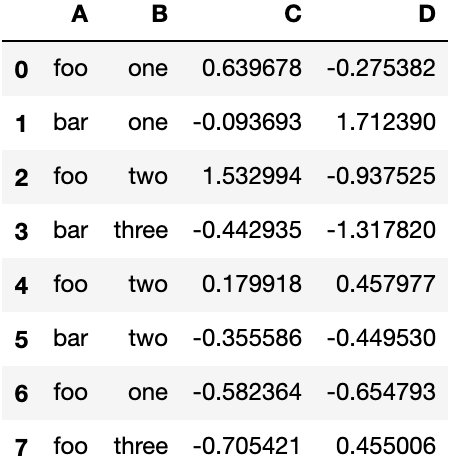
# 先分组,再用 sum()函数计算每组的汇总数据
df.groupby('A').sum()Output:

多列分组后,生成多层索引,也可以应用 sum 函数:
df.groupby(['A', 'B']).sum()
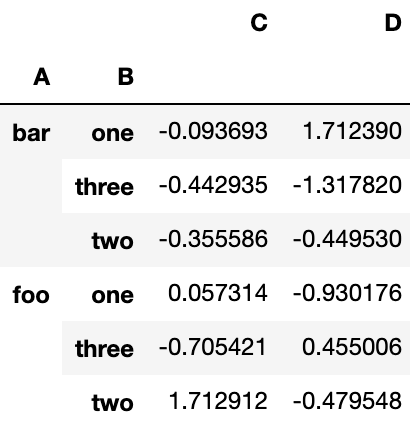
重塑(Reshaping)
堆叠(Stack)
tuples = list(zip(*[['bar', 'bar', 'baz', 'baz',
'foo', 'foo', 'qux', 'qux'],
['one', 'two', 'one', 'two',
'one', 'two', 'one', 'two']]))
index = pd.MultiIndex.from_tuples(tuples, names=['first', 'second'])
df = pd.DataFrame(np.random.randn(8, 2), index=index, columns=['A', 'B'])
df2 = df[:4]
df2Output:

stack()方法把 DataFrame 列压缩至一层:
stacked = df2.stack()
stacked
# Output
first second
bar one A -0.282081
B -1.133788
two A -0.225216
B -1.659150
baz one A 0.281171
B -2.048107
two A 0.697422
B -1.202862
dtype: float64压缩后的 DataFrame 或 Series 具有多层索引, stack() 的逆操作是 unstack(),默认为拆叠最后一层:
stacked.unstack()Output:

stacked.unstack(1)Output:
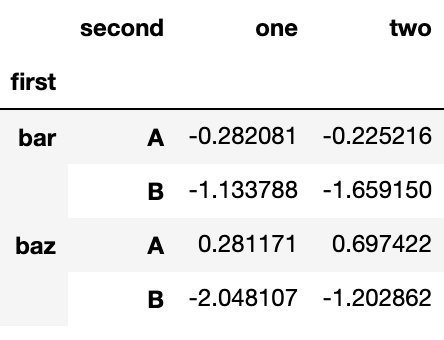
stacked.unstack(0)Output:
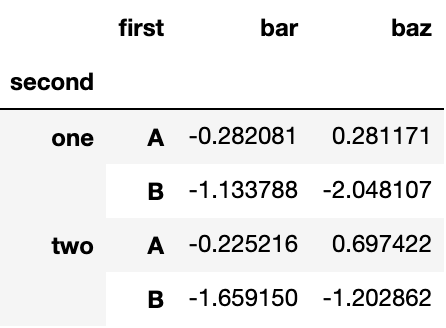
数据透视表(Pivot Tables)
df = pd.DataFrame({'A': ['one', 'one', 'two', 'three'] * 3,
'B': ['A', 'B', 'C'] * 4,
'C': ['foo', 'foo', 'foo', 'bar', 'bar', 'bar'] * 2,
'D': np.random.randn(12),
'E': np.random.randn(12)})
dfOutput:
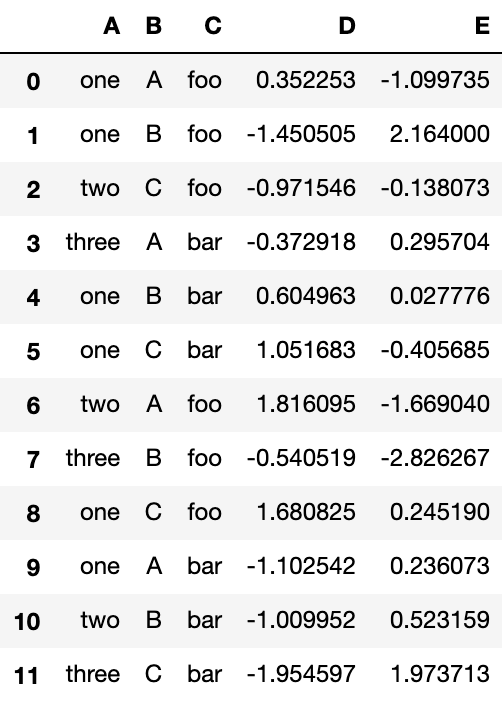
用上述数据生成数据透视表非常简单:
pd.pivot_table(df, values='D', index=['A', 'B'], columns=['C'])Output:

时间序列(TimeSeries)
Pandas 为频率转换时重采样提供了虽然简单易用,但强大高效的功能,如,将秒级的数据转换为 5 分钟为频率的数据。这种操作常见于财务应用程序,但又不仅限于此。
rng = pd.date_range('1/1/2012', periods=100, freq='S')
ts = pd.Series(np.random.randint(0, 500, len(rng)), index=rng)
ts.resample('5Min').sum()
# Output
2012-01-01 27830
Freq: 5T, dtype: int64
# 时区表示
rng = pd.date_range('3/6/2012 00:00', periods=5, freq='D')
ts = pd.Series(np.random.randn(len(rng)), rng)
ts
# Output
2012-03-06 -0.122874
2012-03-07 3.048883
2012-03-08 0.974570
2012-03-09 0.676963
2012-03-10 1.857628
Freq: D, dtype: float64
ts_utc = ts.tz_localize('UTC')
ts_utc
# Output
2012-03-06 00:00:00+00:00 -0.122874
2012-03-07 00:00:00+00:00 3.048883
2012-03-08 00:00:00+00:00 0.974570
2012-03-09 00:00:00+00:00 0.676963
2012-03-10 00:00:00+00:00 1.857628
Freq: D, dtype: float64
# 转换成其它时区
ts_utc.tz_convert('US/Eastern')
# Output
2012-03-05 19:00:00-05:00 -0.122874
2012-03-06 19:00:00-05:00 3.048883
2012-03-07 19:00:00-05:00 0.974570
2012-03-08 19:00:00-05:00 0.676963
2012-03-09 19:00:00-05:00 1.857628
Freq: D, dtype: float64
# 转换时间段
rng = pd.date_range('1/1/2012', periods=5, freq='M')
ts = pd.Series(np.random.randn(len(rng)), index=rng)
ts
# Output
2012-01-31 -1.263639
2012-02-29 -0.101891
2012-03-31 -0.578687
2012-04-30 -1.472608
2012-05-31 0.565977
Freq: M, dtype: float64
ps = ts.to_period()
ps
# Output
2012-01 -1.263639
2012-02 -0.101891
2012-03 -0.578687
2012-04 -1.472608
2012-05 0.565977
Freq: M, dtype: float64
ps.to_timestamp()
# Output
2012-01-01 -1.263639
2012-02-01 -0.101891
2012-03-01 -0.578687
2012-04-01 -1.472608
2012-05-01 0.565977
Freq: MS, dtype: float64Pandas 函数可以很方便地转换时间段与时间戳。下例把以 11 月为结束年份的季度频率转换为下一季度月末上午 9 点:
prng = pd.period_range('1990Q1', '2000Q4', freq='Q-NOV')
ts = pd.Series(np.random.randn(len(prng)), prng)
ts.index = (prng.asfreq('M', 'e') + 1).asfreq('H', 's') + 9
ts.head()
# Output
1990-03-01 09:00 -1.147739
1990-06-01 09:00 1.924324
1990-09-01 09:00 -0.451538
1990-12-01 09:00 0.978331
1991-03-01 09:00 -0.419933
Freq: H, dtype: float64类别型(Categoricals)
Pandas 的 DataFrame 里可以包含类别数据。API 文档
df = pd.DataFrame({"id": [1, 2, 3, 4, 5, 6],
"raw_grade": ['a', 'b', 'b', 'a', 'a', 'e']})
# 将 grade 的原生数据转换为类别型数据
df["grade"] = df["raw_grade"].astype("category")
df["grade"]
# Output
0 a
1 b
2 b
3 a
4 a
5 e
Name: grade, dtype: category
Categories (3, object): [a, b, e]用有含义的名字重命名不同类型,调用 Series.cat.categories。
df["grade"].cat.categories = ["very good", "good", "very bad"]重新排序各类别,并添加缺失类,Series.cat 的方法默认返回新 Series。
df["grade"] = df["grade"].cat.set_categories(["very bad", "bad", "medium",
"good", "very good"])
df["grade"]
# Output
0 very good
1 good
2 good
3 very good
4 very good
5 very bad
Name: grade, dtype: category
Categories (5, object): [very bad, bad, medium, good, very good]注意,这里是按生成类别时的顺序排序,不是按词汇排序:
df.sort_values(by="grade")Output:

按类列分组(groupby)时,即便某类别为空,也会显示:
df.groupby("grade").size()
# Output
grade
very bad 1
bad 0
medium 0
good 2
very good 3
dtype: int64可视化
ts = pd.Series(np.random.randn(1000),
index=pd.date_range('1/1/2000', periods=1000))
ts = ts.cumsum()
ts.plot()Output:
<matplotlib.axes._subplots.AxesSubplot at 0x11a89e240>

DataFrame 的 plot() 方法可以快速绘制所有带标签的列:
df = pd.DataFrame(np.random.randn(1000, 4), index=ts.index,
columns=['A', 'B', 'C', 'D'])
df = df.cumsum()
import matplotlib.pyplot as plt
plt.figure()
df.plot()
plt.legend(loc='best')Output:
<matplotlib.legend.Legend at 0x11c9dc198>
<Figure size 432x288 with 0 Axes>
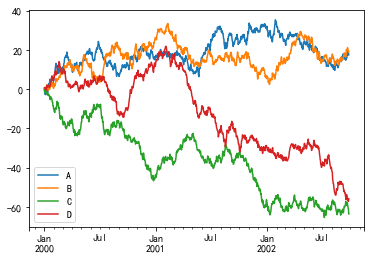
数据输入 / 输出
CSV
# 写入 CSV 文件
df.to_csv('foo.csv')
# 读取 CSV 文件数据
pd.read_csv('foo.csv')HDF5
# 写入 HDF5 Store
df.to_hdf('foo.h5', 'df')
# 读取 HDF5 Store
pd.read_hdf('foo.h5', 'df')Excel
# 写入 Excel 文件
df.to_excel('foo.xlsx', sheet_name='Sheet1')
# 读取 Excel 文件
pd.read_excel('foo.xlsx', 'Sheet1', index_col=None, na_values=['NA'])各种坑(Gotchas)
执行某些操作,将触发异常,如:
>>> if pd.Series([False, True, False]):
... print("I was true")
Traceback
...
ValueError: The truth value of an array is ambiguous. Use a.empty, a.any() or a.all().参阅比较操作文档,查看错误提示与解决方案。详见各种坑文档。Pandas
本作品采用《CC 协议》,转载必须注明作者和本文链接




 关于 LearnKu
关于 LearnKu



